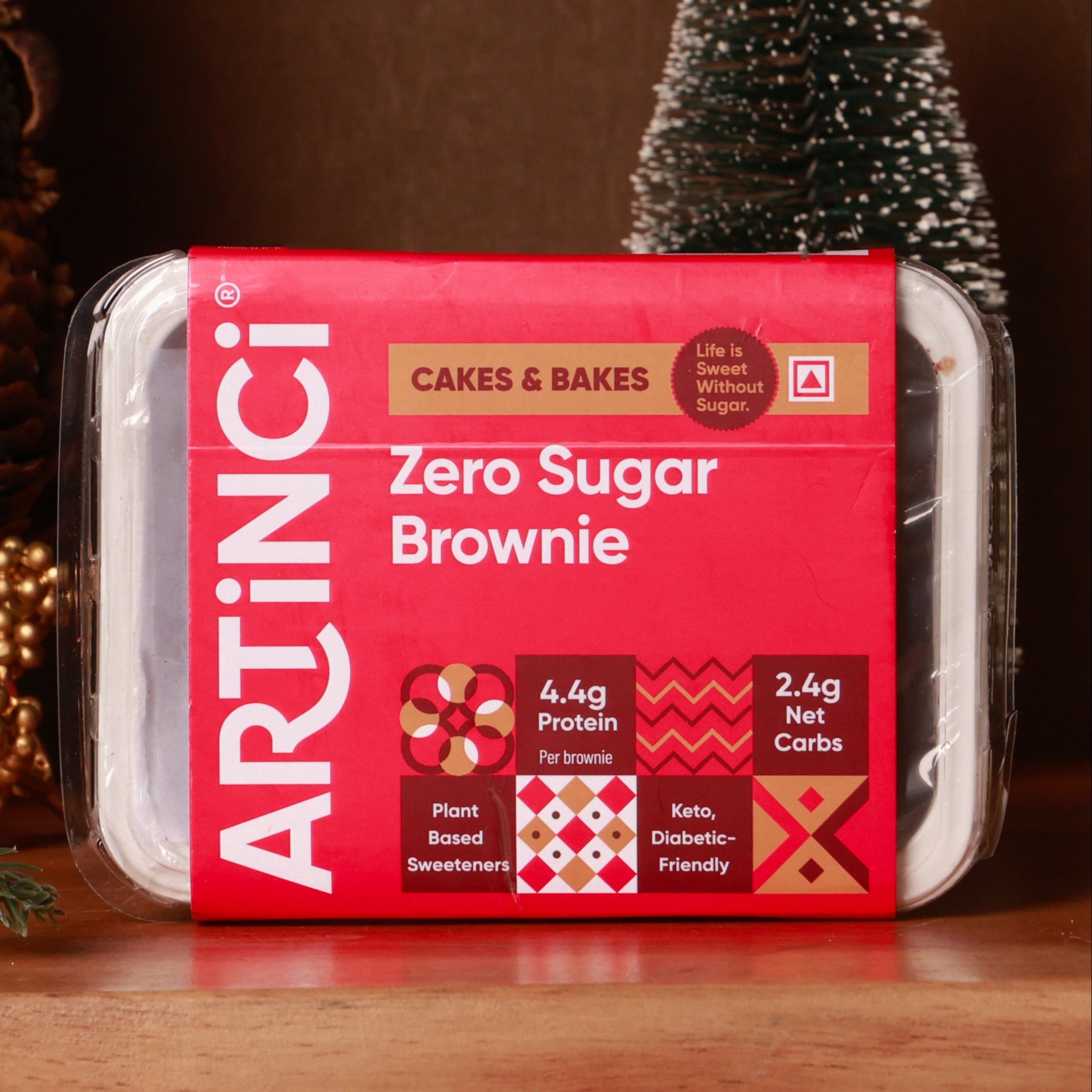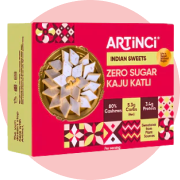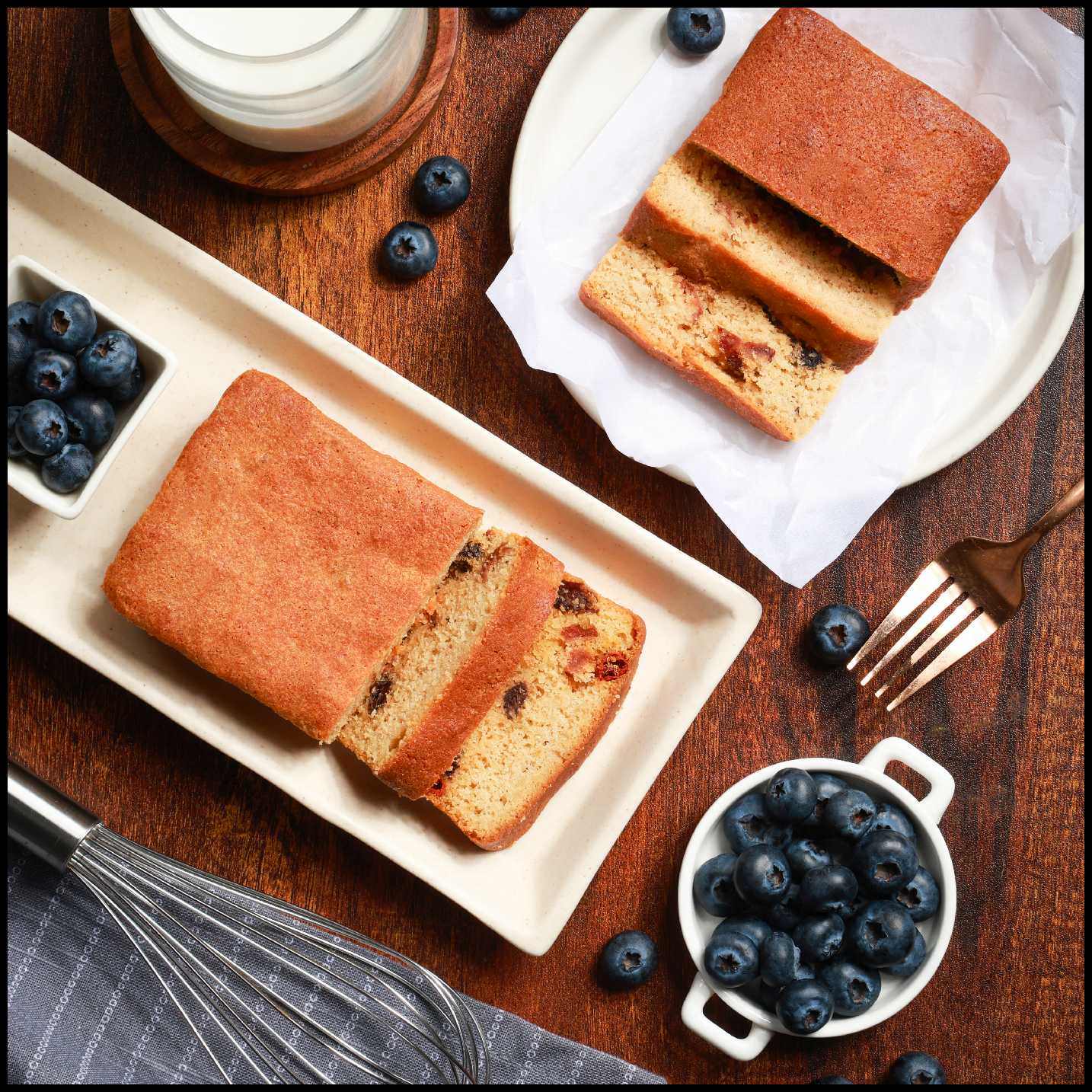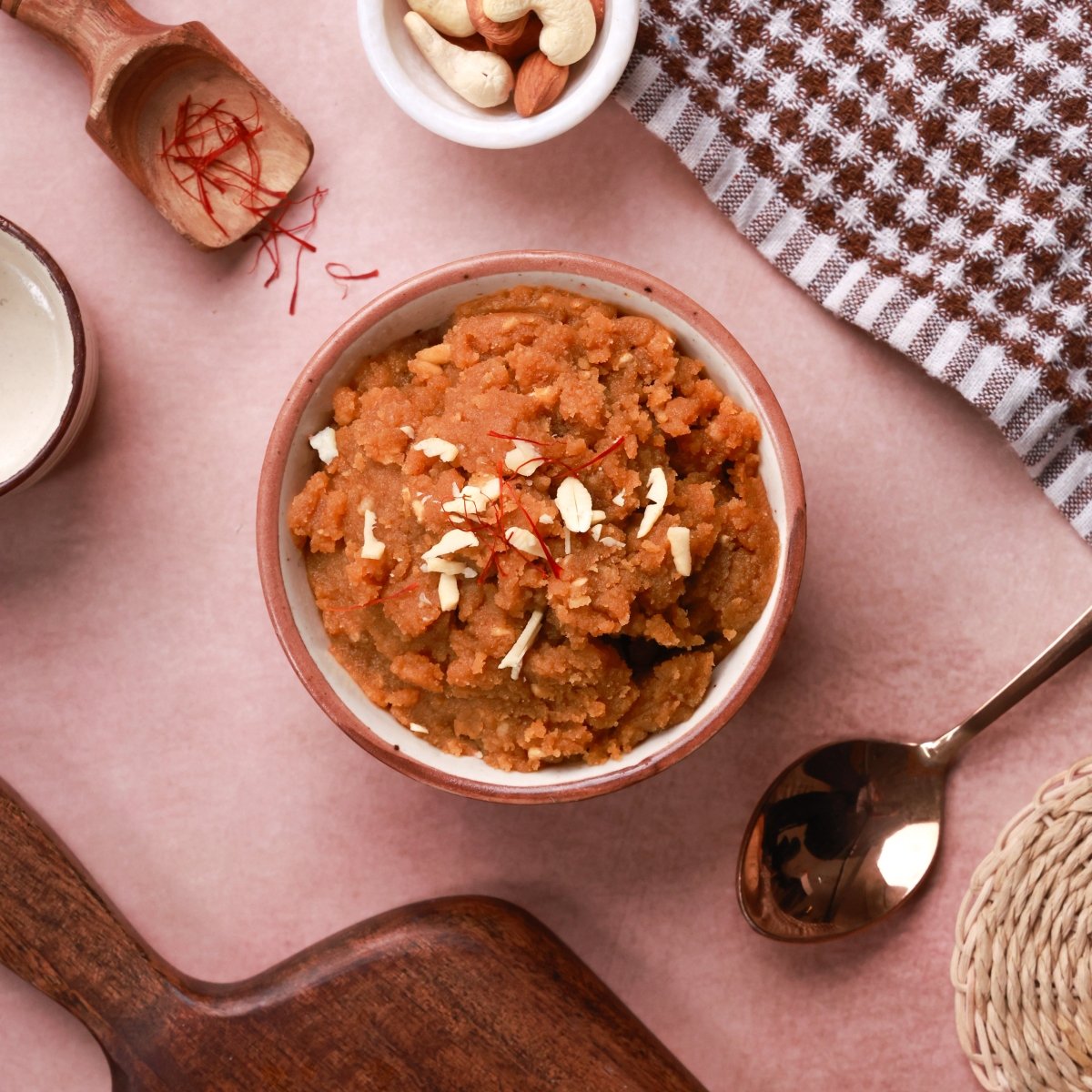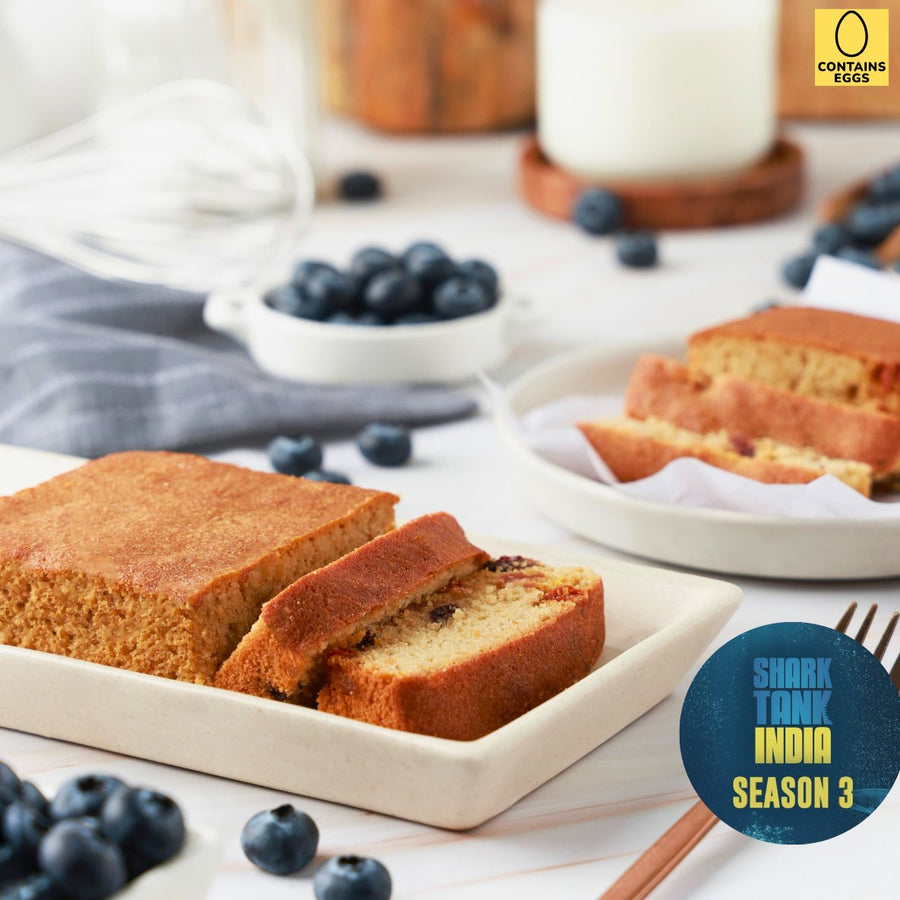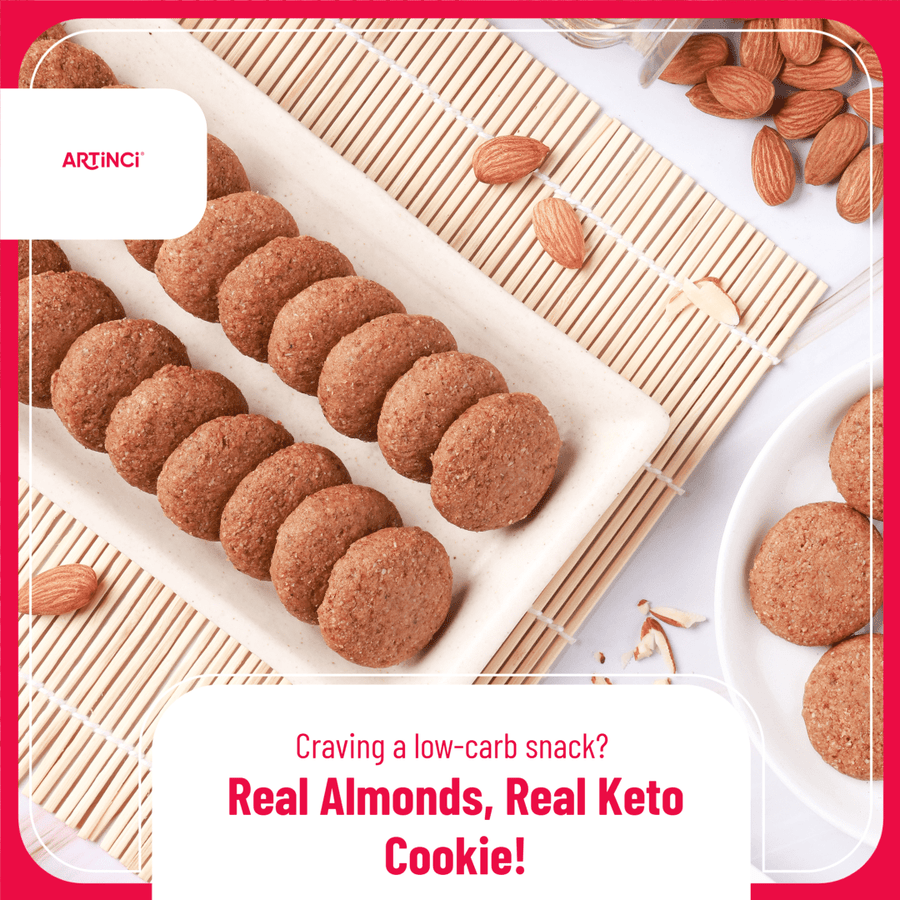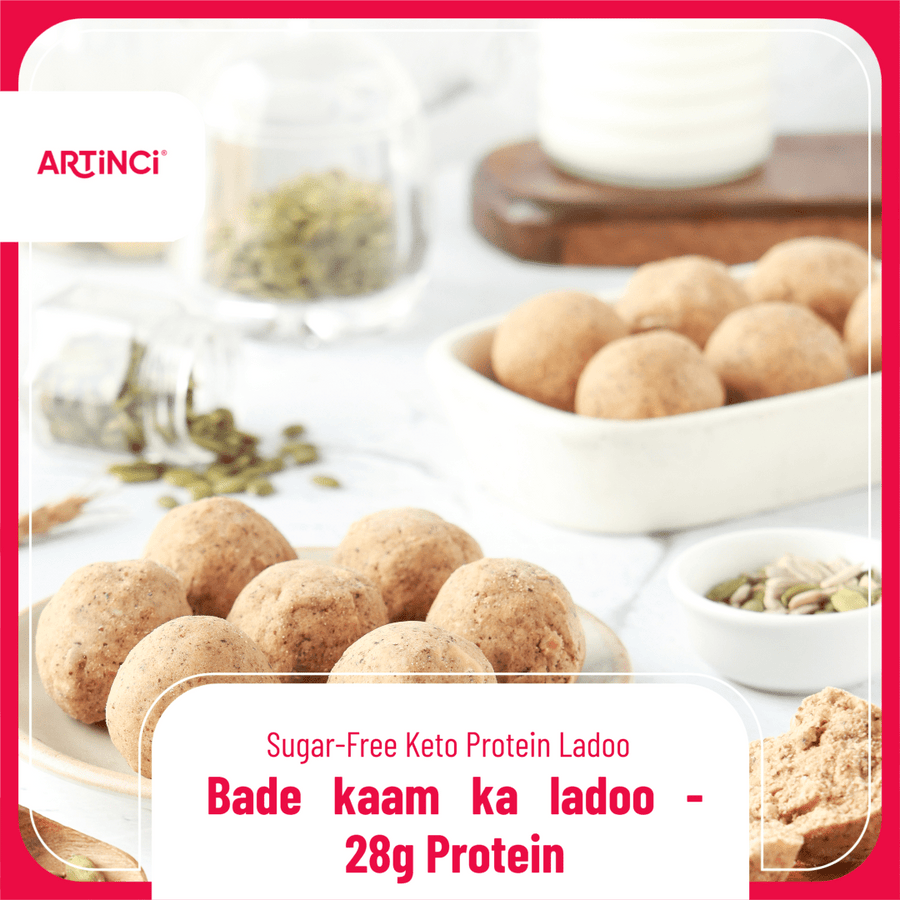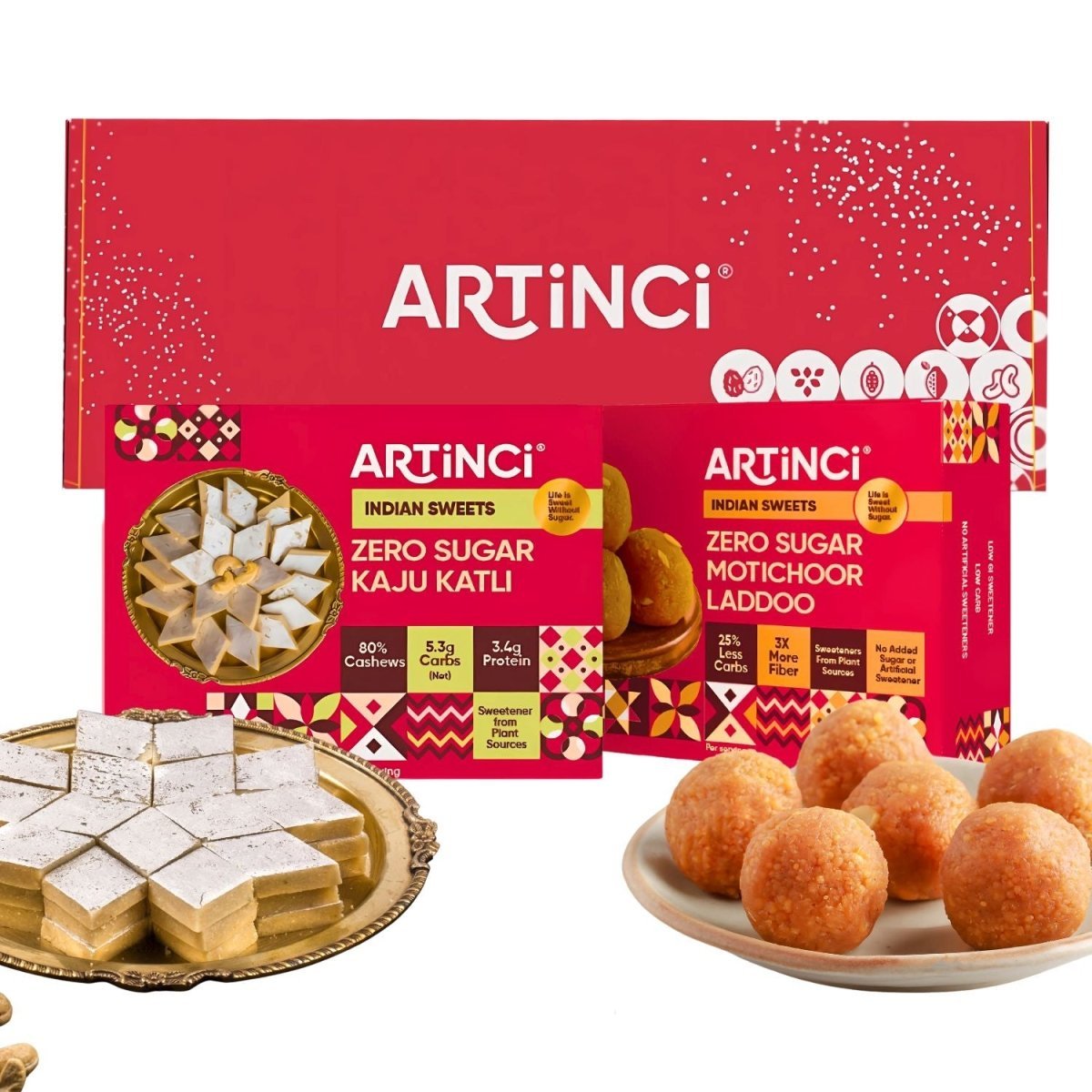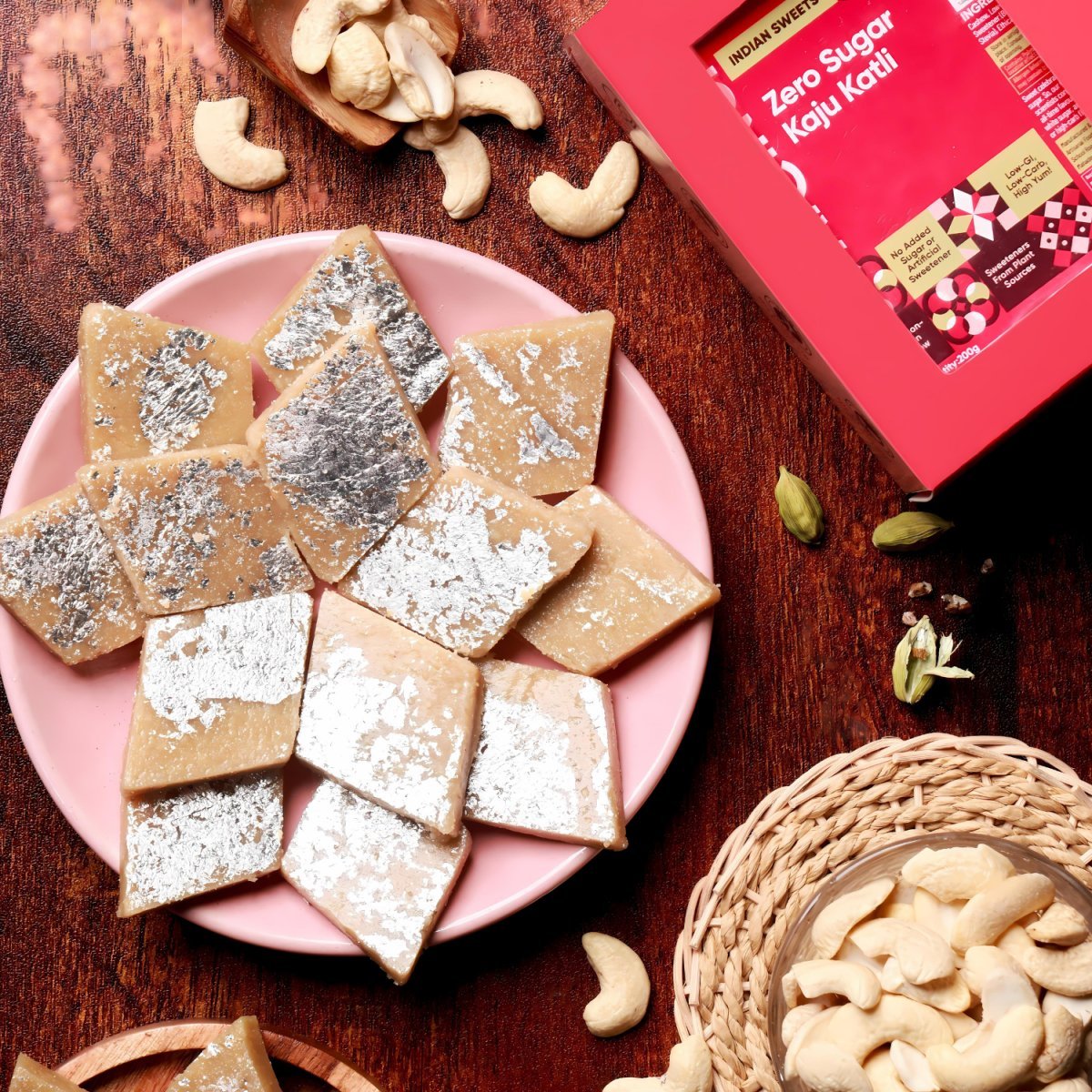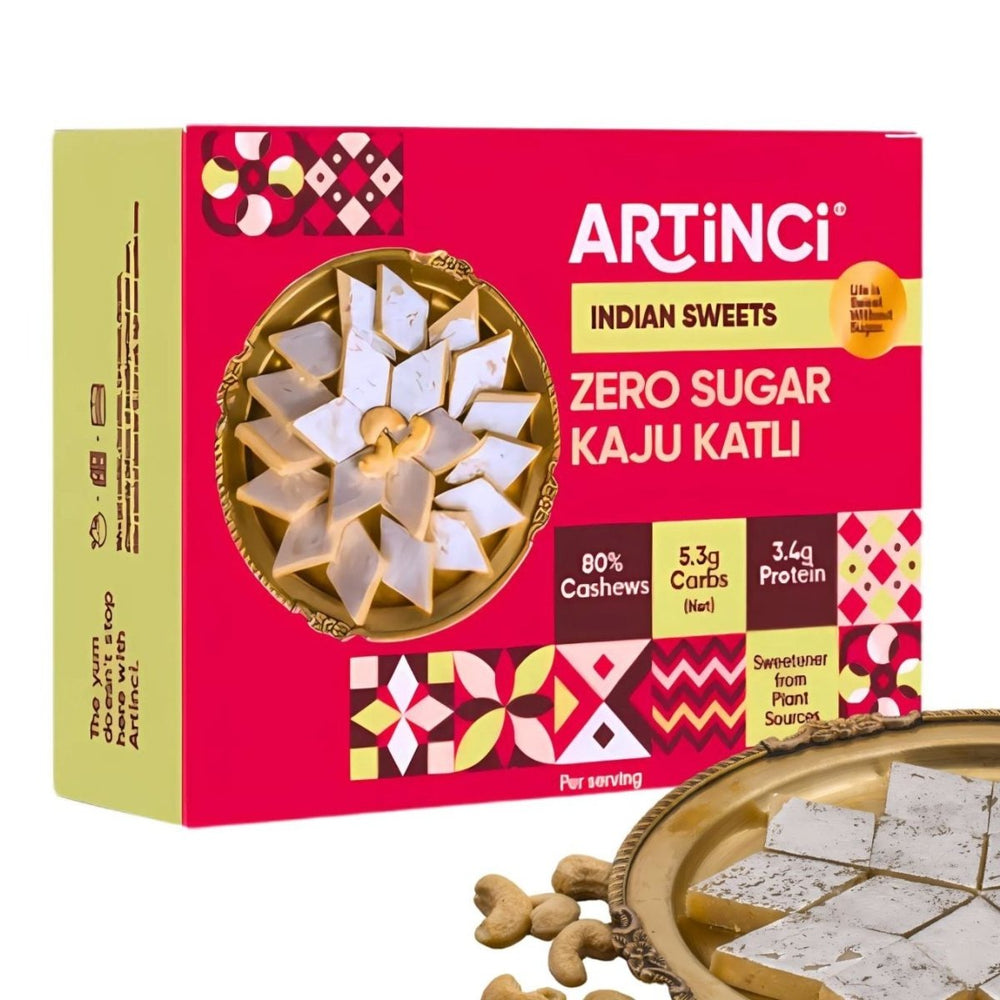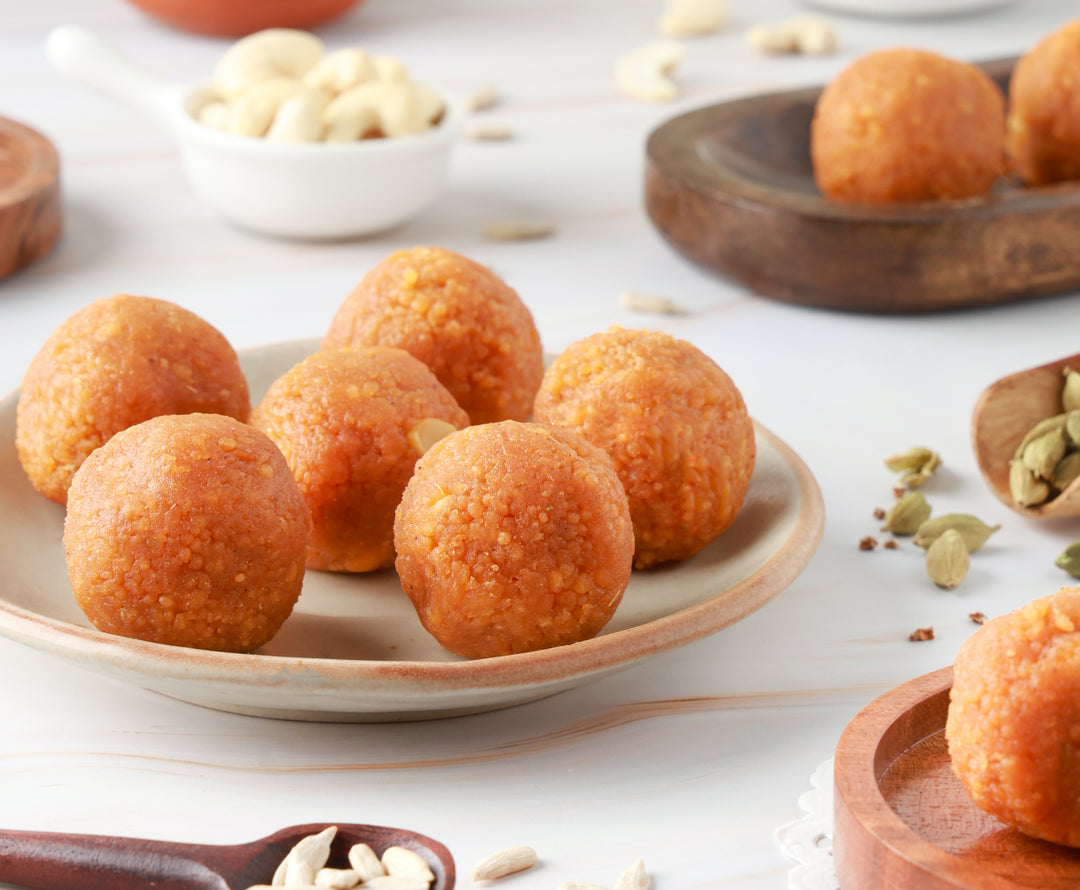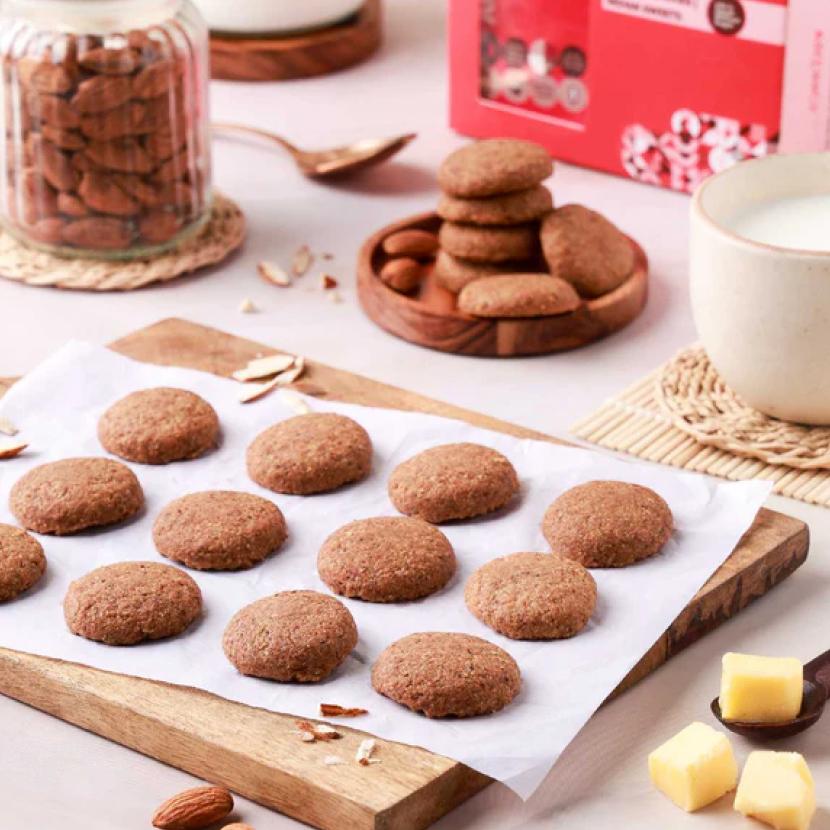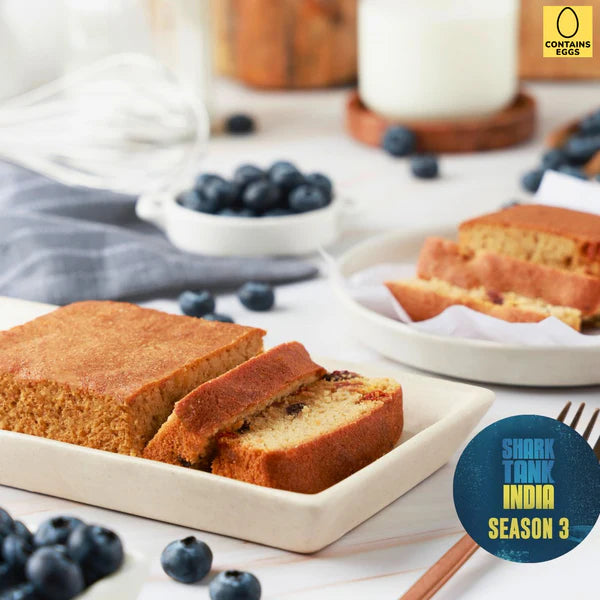Welcome to the world of sugar free joy!
Low Carb Sugar-Free Desserts & Snacks
Artinci was born out of Aarti's and Sumit's (Artinci's founders) abiding love for great-tasting dessert, while helping them stay committed to their health goals as well. As a result, Artinci makes delicious desserts with zero sugar, that are science and evidence-backed.
Aarti and Sumit come from a family of three generations of diabetics. They were themselves diagnosed pre-diabetic in 2012, and right there began a lifelong quest of a healthy, active lifestyle, including healthy swaps in food
Indulgent Halwas & Cozy Cakes


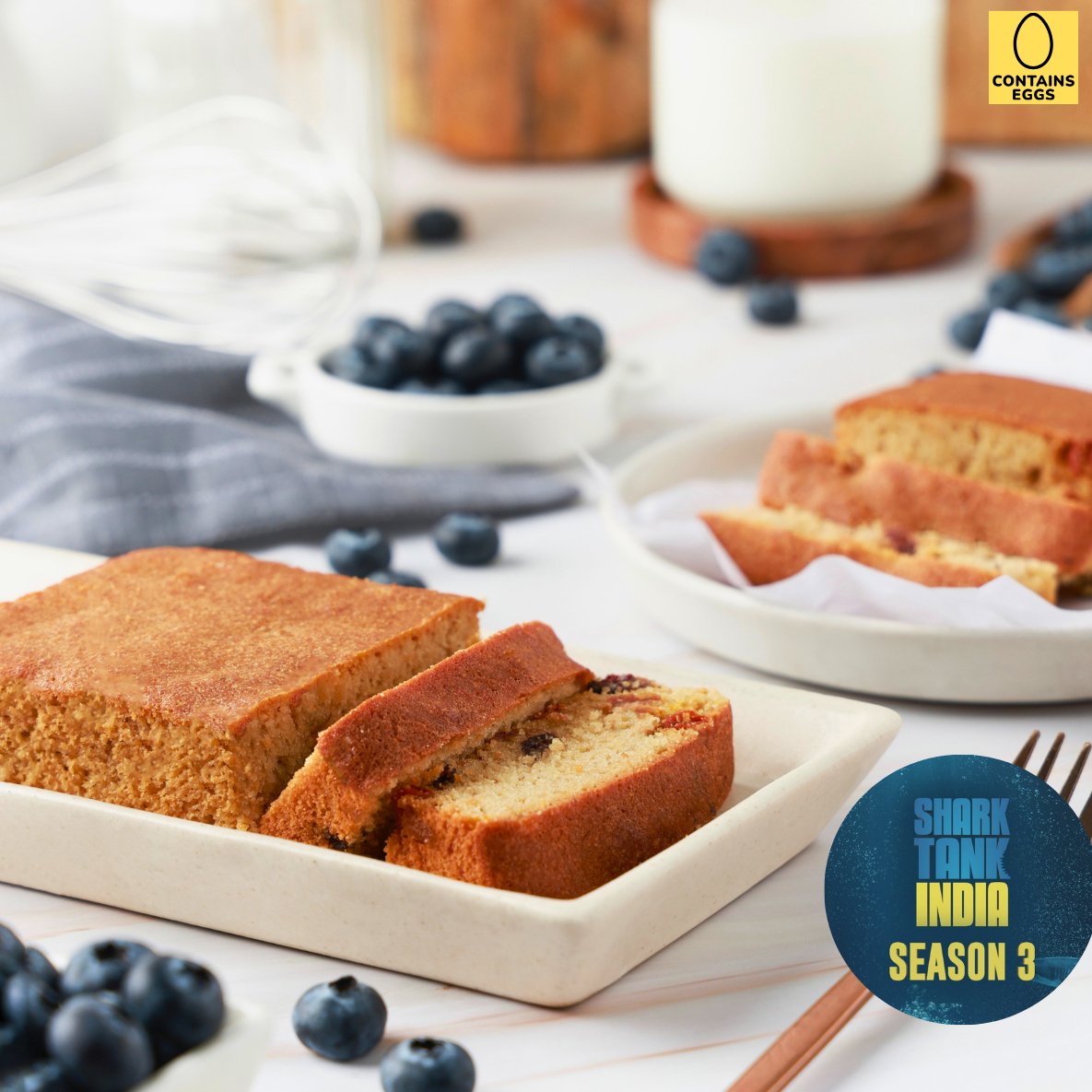


Berries Almond Cake - Made with 100% Almond Flour, Sugar Free, Keto, Gluten Free

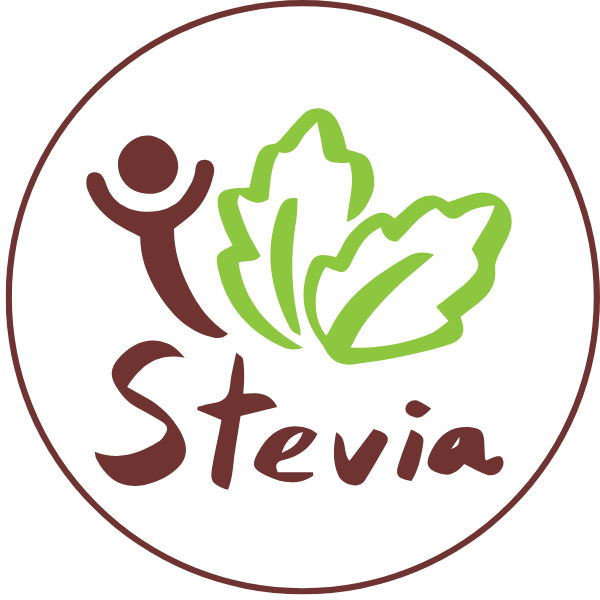

Winter special sugar free halwa combo @499



Aarti Laxman (Founder)
Artinci is founded by Aarti Laxman, a certified Metabolic coach in the Low-Carb Nutrition & Metabolic Health domain from dLife.in, India’s only legally tenable course in this subject—recognized by the NSDC (under the Ministry of Skill Development & Entrepreneurship, Govt. of India). It’s also internationally accredited by the CPD Standards Office UK, with a global record of 144 CPD hours—the highest for any course of its kind. The accreditation is both nationally valid and globally recognised in over 50+ countries..
Festive Gifting in Artinci
Let customers speak for us
All about Sugar and sugar-free

Have you ever wondered why some foods taste amazing to you while others make you cringe? Your brain plays a fascinating role in determining what ends up on your "delicious" list, particularly through the process of taste perception in the brain. Just like learning a new language or skill, you can train your brain to appreciate and love new flavors.Understanding the Role of Your Brain in Taste PerceptionThink of your taste buds as students, ready to learn and expand their horizons. Through mindful eating practices and repeated exposure to different foods, you can transform your relationship with previously challenging ingredients. The secret lies in understanding how your brain processes taste perception in the brain and implementing simple techniques to rewire those responses.Exploring Sweetness: The Power of ErythritolA great way to start this journey is by experimenting with different types of sweeteners. For instance, erythritol, a sugar-free substitute, has been gaining popularity due to its various benefits and suitability for those on keto or diabetic-friendly diets. Incorporating such alternatives can help you enjoy sweets guilt-free while also training your brain to accept new flavors.Expanding Your Palate: Discovering Traditional Indian SweetsReady to embark on a flavor adventure? Let's explore how incorporating real, whole ingredients and practical strategies into your daily routine can open up a world of culinary possibilities you never thought possible. For example, indulging in traditional Indian sweets like Kaju Katli and Motichoor Ladoo can be a delightful experience that broadens your palate. These treats are not only delicious but also cater to various dietary needs such as being gluten-free or sugar-free.Understanding the Brain-Food ConnectionYour brain processes taste through a fascinating network of neural pathways. When you take a bite, taste buds send signals to specific areas in your brain, creating a complex flavor perception that combines: Chemical sensing - detecting sweet, sour, salty, bitter, and umami Texture recognition - processing mouth-feel and consistency Memory association - linking tastes to past experiences Emotional response - creating feelings about specific foods The magic happens through repeated exposure. Each time you try a new food, your brain forms neural pathways that become stronger with practice. Think of it like learning a new language - the more you practice, the more natural it feels.Research shows it takes about 8-15 exposures for your brain to adapt to unfamiliar tastes. This explains why children who initially reject certain vegetables often grow to enjoy them after multiple tastings. Your brain's natural plasticity allows it to rewire its response to new flavors, transforming initial aversion into genuine appreciation.In this context, exploring a variety of foods can significantly aid in this adaptation process. For instance, trying out some of the best-selling sugar-free sweets from Artinci, which include an array of cakes, cookies, and Indian sweets, could provide delightful experiences that help reshape your taste preferences.The Influence of Texture on Flavor PerceptionYour brain processes texture and taste simultaneously, creating a complex sensory experience that shapes your food preferences. Think about biting into a crispy apple versus eating applesauce – while the flavor remains similar, the eating experience differs dramatically.Texture plays a vital role in: Mouthfeel satisfaction - The way food feels in your mouth can trigger pleasure or aversion responses Flavor release - Different textures affect how quickly taste compounds reach your taste buds Memory association - Texture creates lasting impressions that influence future food choices Understanding texture preferences can help you overcome food aversions. If you dislike mushrooms' sponginess, try them crispy and roasted. Can't stand the smoothness of avocados? Try them mashed with chunky vegetables.The key lies in texture transformation. Many foods can be prepared with different textures while maintaining their nutritional benefits: Steamed vegetables vs. roasted vegetables Pureed soups vs. chunky stews Raw nuts vs. nut butters By experimenting with various cooking methods and food preparations, you can discover textures that make new foods more appealing to your palate.Incorporating sugar-free sweeteners into your diet can also help manage certain food textures and flavors. For those on specific dietary plans like keto or gluten-free, exploring options such as our Almond Cake, which is sweetened with stevia and perfect for a keto-friendly diet, could be beneficial.Overcoming Food Aversions Through Open-MindednessFood aversions often come from negative past experiences or preconceived ideas. To overcome these mental barriers, you need a strategic plan to retrain your brain.Practical Steps to Transform Food Aversions: Start with small portions mixed into familiar dishes Focus on the positive qualities of new foods Create enjoyable dining environments to build positive associations Challenge negative beliefs about specific ingredients Your mindset plays a crucial role in how you perceive taste. Research shows that approaching new foods with curiosity instead of fear can greatly improve your eating experience.Consider documenting your food journey through photos or a taste diary. This practice helps track progress and celebrate small victories as you expand your palate.Quick Tips for Success: Pair unfamiliar foods with favorite flavors Experiment with different cooking methods for challenging ingredients Set realistic goals - aim to try one new food each week Remember that taste preferences can change with repeated exposure The key is to create positive associations with new foods while maintaining a growth mindset about your cooking abilities.The Importance of Real Ingredients in Flavorful CookingReal ingredients create a symphony of authentic flavors that processed foods simply can't replicate. Each whole ingredient brings its unique character to your cooking: Natural Complexity: Fresh herbs release aromatic compounds that dance on your tongue Pure Flavors: Unprocessed vegetables maintain their inherent sweetness and mineral notes Rich Textures: Whole grains offer satisfying chewiness and nutty undertones The magic of real ingredients extends beyond taste - they nourish your body at a cellular level, influencing taste perception in the brain. A fresh tomato delivers lycopene, vitamin C, and potassium in their most bioavailable forms. These natural compounds trigger satisfaction signals in your brain, reducing cravings and creating genuine enjoyment of wholesome foods.Your body recognizes and responds to these natural compounds in ways it can't with artificial alternatives. This biological recognition triggers satisfaction signals in your brain, reducing cravings and creating genuine enjoyment of wholesome foods.Cooking with real ingredients also helps develop a deeper connection with your food. You'll notice subtle seasonal variations in produce, appreciate the distinct characteristics of different olive oils, and discover how ingredients interact to create memorable meals.Moreover, incorporating healthier alternatives like monk fruit as a sweetener can be beneficial for those managing dietary restrictions while considering taste perception in the brain. Jaggery, which contains fewer empty carbs and has a lower glycemic index compared to sugar, could serve as a healthier substitute.Getting Creative with Whole Ingredients: Recipes to TryLet's explore some delicious recipes that make incorporating whole ingredients an exciting culinary adventure:Vegetarian: Moong Dal Khichdi with Ghee-TadkaWhy it works: Balanced, easy to digest, and packed with protein and fiber.Ingredients: Whole moong dal (green gram) Brown rice or millets (like little millet or foxtail millet) Fresh vegetables (carrot, beans, bottle gourd) Ginger, garlic, turmeric Cumin, ghee, and asafoetida (hing) for tadka Fresh coriander and lemon for garnish Health Highlight: This one-pot comfort meal is rich in plant-based protein, gut-friendly, and can be made without any processed ingredients. A go-to for light, nourishing dinners.Non-Vegetarian: Chicken Sukka (Dry Chicken Masala)Why it works: Uses real spices, no cream or refined ingredients, and pairs well with wholesome sides like jowar roti or red rice.Ingredients: Free-range chicken Freshly ground coconut, ginger, garlic Curry leaves, dry red chilies, black pepper Mustard seeds, turmeric, and coriander powder Coconut oil Health Highlight: A traditional dish that’s high in protein and healthy fats from coconut. Richly spiced and satiating, without relying on heavy oils or artificial flavoring.Experimentation and Patience: The Keys to Expanding Your PalateDeveloping a diverse palate requires a mindset shift - think of yourself as a food explorer on an exciting journey of discovery. Your taste preferences can evolve through strategic experimentation: Start Small: Mix tiny amounts of new ingredients into familiar dishes Play with Temperature: Try foods both hot and cold to find your preferred way Experiment with Preparation: Steam, roast, or sauté - different cooking methods create unique flavor profiles Remember that it takes an average of 10-15 exposures for your brain to adapt to new tastes. Some tips to make the process easier: Keep a food journal to track your progress Celebrate small wins when you discover new favorites Take breaks between trying challenging foods Focus on one new ingredient at a time Your brain's neural pathways strengthen with each exposure to unfamiliar flavors. This biological process can't be rushed - it's like learning a new language or instrument. The key lies in consistent, gentle exposure rather than forcing yourself to eat large quantities of foods you currently dislike.ConclusionYour journey to discover new tastes is a powerful path to better health and richer culinary experiences. Each bite of real, whole ingredients opens doors to unexpected flavors and nourishes your body in profound ways.However, if you're feeling overwhelmed or frustrated with the process, remember that it's okay to take a step back and approach it at your own pace. Listen to your body and intuition as you explore new flavors, and don't hesitate to seek guidance from professionals like nutritionists or chefs for support along the way.Ready to embrace new flavors while making healthier choices? Discover Artinci’s delicious range of sugar-free products and satisfy your sweet tooth—guilt-free! Explore our collection today and experience real taste without the sugar. Try Artinci now!Disclaimer: The information provided in this article is for educational purposes only and should not be taken as medical advice. Please consult with a healthcare professional before making any dietary changes, especially if you have any underlying health conditions. FAQs1.How does the brain influence our perception of taste and enjoyment of new flavors?The brain plays a crucial role in interpreting taste and texture, which directly affects how we perceive and enjoy different flavors. By understanding this brain-food connection, we can train our brains through repeated exposure to appreciate unfamiliar tastes and expand our palate.2.Why is texture important in flavor perception and food enjoyment?Texture significantly impacts how we experience food, as it can enhance or hinder flavor perception. Different textures can alter the way flavors are perceived by the brain, making it an essential factor to consider when trying new foods or training your brain to love new flavors.3.What strategies can help overcome food aversions and encourage trying new dishes?Overcoming food aversions involves adopting an open-minded approach to culinary experiences. Being willing to try a variety of dishes with different ingredients and textures can retrain your brain to enjoy new flavors, ultimately broadening your dietary preferences.4.Why are real, whole ingredients important for flavorful cooking and health?Using whole, unprocessed ingredients is vital because they not only enhance the complexity of flavors but also provide essential nutrients that nourish both the body and mind. Real ingredients contribute to more delicious meals while supporting overall health and well-being.5.How can experimentation and patience aid in expanding one's palate?Experimentation allows you to explore diverse cuisines and ingredients, preparing your taste buds for unfamiliar foods. Patience is key because developing a more varied palate takes time as your brain gradually adapts to new tastes and textures through consistent exposure.

What Fruits Should Diabetics Avoid? The Ultimate Guide
Living with diabetes requires careful attention to blood sugar management. Every food choice impacts glucose levels, making dietary decisions crucial for maintaining stable blood sugar. While fruits are often celebrated for their nutritional benefits, their natural sugar content can present challenges for people with diabetes. Choosing low glycemic fruits can be an effective way to enjoy the health benefits of fruit while managing blood sugar levels more effectively. This guide empowers you to make smart fruit choices for your diabetic diet. We'll explore which fruits to limit, which to embrace, and why these distinctions matter for your blood sugar control. Armed with this knowledge, you can enjoy the sweetness of fruits while maintaining your health goals. Understanding the Impact of Fruits on Blood Sugar Levels Natural sugars in fruits interact with your blood glucose levels in unique ways. While fruits contain fructose - a natural sugar - their impact on blood sugar varies significantly based on two key factors: fiber content and portion size. The Fiber Factor Fruits rich in fiber slow down sugar absorption into your bloodstream, creating a gradual rise rather than a sudden spike. This fiber acts as a natural buffer, helping maintain stable blood glucose levels. For example, a medium apple contains 4.5g of fiber alongside its natural sugars, making it a smarter choice for blood sugar management. Portion Control Matters The amount of fruit you eat directly influences your blood sugar response: A small serving (½ cup) of fruit typically contains 15g of carbohydrates Larger portions can lead to higher sugar absorption Spreading fruit consumption throughout the day helps prevent blood sugar spikes Additionally, employing some simple strategies to prevent blood sugar spikes after meals can further aid in managing your blood glucose levels effectively. Blood Sugar Impact Scale Different fruits affect blood sugar at varying rates: Low impact: Berries, apples, pears Medium impact: Oranges, peaches High impact: Watermelon, ripe bananas In managing blood sugar levels, it's also worth considering alternatives like erythritol, a sugar-free substitute that has gained popularity due to its benefits and lower impact on blood glucose. Additionally, incorporating sugar-free products into your diet can help manage sugar intake effectively. These products are designed with careful consideration of ingredients to ensure they are both tasty and beneficial for health. For instance, Artinci offers a range of sugar-free sweets that are diabetic-friendly and made with high-quality ingredients. Their product philosophy emphasizes scientific research to create products that not only taste good but also cater to specific dietary needs. Moreover, if you're looking for delightful treats that align with your health goals, consider exploring Artinci's Kaju Katli and Motichoor Ladoo combo, which could be an excellent option for festive gifting while still being mindful of sugar intake. Fruits Diabetics Should Avoid or Limit While fruits offer essential nutrients, some varieties can significantly impact blood sugar levels. Here's a detailed list of fruits that require careful consideration: High Sugar Fruits to Watch: Here are ~100-word explanations for each high-sugar fruit and why they are not ideal for individuals with diabetes, considering their sugar content and impact on blood glucose: 1. Dates (Dried) – 63g Sugar per 100g Dates are one of the highest-sugar fruits available, with about 63g of sugar per 100g. Even though they are rich in fiber, iron, and potassium, their dense sugar concentration makes them unsuitable for diabetics. The natural sugars—mainly glucose and fructose—can lead to a sharp rise in blood glucose levels. Just 2–3 dates can deliver the sugar equivalent of an entire meal for a diabetic person. Variants like Medjool or Deglet Noor may differ slightly in size and sweetness but are all high in sugar. Dates should be avoided or eaten in extremely limited quantities. 2. Figs (Dried) – 48g Sugar per 100g Dried figs are naturally sweet and nutrient-dense, but they pack a punch when it comes to sugar—around 48g per 100g. They contain natural sugars like fructose and glucose, which quickly enter the bloodstream and spike blood sugar levels. While figs do offer some fiber and minerals, dried versions are far more concentrated in sugar than fresh ones. For diabetics, even a small handful can result in hyperglycemia. Variants like Black Mission or Smyrna figs have similar sugar content. If consumed at all, it’s crucial to pair them with a source of protein or fat to slow down absorption. 3. Grapes – 16g Sugar per 100g Grapes are a convenient and refreshing snack but are deceptively high in natural sugars—about 16g per 100g. Most of this sugar is glucose and fructose, which cause rapid increases in blood glucose. While grapes contain antioxidants like resveratrol, their high glycemic load can pose problems for diabetics. Varieties such as red, green, or black grapes all have similar sugar content, with green grapes sometimes being slightly less sweet. Since grapes are small and easy to overeat, portion control becomes difficult. Diabetics are better off avoiding them or consuming very small amounts with a protein-rich food to offset glucose spikes. 4. Chikoo (Sapota) – 14g Sugar per 100g Chikoo, or sapota, is a tropical fruit that’s beloved for its caramel-like flavor. However, it's extremely high in sugar—about 14g per 100g—and primarily composed of sucrose, fructose, and glucose. It’s low in fiber and high in carbs, which makes it a poor choice for diabetics. The fruit’s sugar content can vary with ripeness—fully ripe chikoo has even higher sugar levels. Eating even one fruit can lead to a significant blood sugar rise. Its glycemic index is also high, and regular consumption can make managing blood sugar very challenging for diabetic individuals. 5. Mango – 14g Sugar per 100g Mangoes are often called the "king of fruits" in India, but their high sugar content—roughly 14g per 100g—makes them unsuitable for diabetic diets. The sweetness in mango comes from a mix of fructose, sucrose, and glucose, which are rapidly digested and absorbed. Different varieties like Alphonso, Kesar, or Langda differ slightly in taste but are all high in natural sugars. While mangoes do contain vitamin C and antioxidants, their high glycemic load can cause a rapid rise in blood sugar. Eating them in moderation is key, but many diabetics may be better off avoiding them entirely. 6. Lychee – 15g Sugar per 100g Lychees are juicy and aromatic, but they contain around 15g of sugar per 100g—most of which is fructose and glucose. These sugars are quickly metabolized and can lead to post-meal spikes in blood glucose levels. Lychees have a relatively high glycemic index and provide minimal fiber, which exacerbates the problem for diabetics. Though they offer some vitamin C and antioxidants, the sugar concentration outweighs the benefits for those trying to control their blood sugar. Canned lychees, which are often packed in syrup, are even worse and should be completely avoided. 7. Banana (Ripe) – 12g Sugar per 100g Ripe bananas are among the most commonly consumed fruits, yet they contain around 12g of sugar per 100g. As they ripen, starches convert into sugars—mostly glucose and fructose—making them very sweet and rapidly digestible. This can be problematic for diabetics, especially when combined with other carbohydrate-rich foods. Varieties like Robusta, Rasthali, and Dwarf Cavendish all carry similar sugar loads. Though bananas provide potassium and B vitamins, their glycemic response is high. A small unripe banana may be a better option occasionally, but ripe bananas should be eaten in strict moderation, if at all. 8. Pineapple – 10g Sugar per 100g Pineapples are tropical fruits rich in vitamin C and bromelain, but they contain about 10g of sugar per 100g. This sugar is primarily glucose and sucrose, both of which are absorbed quickly into the bloodstream. Pineapple has a high glycemic index, making it a poor choice for blood sugar control. The sugar concentration increases in ripe pineapples and in canned or juiced forms. Even small servings can lead to post-meal glucose surges. Diabetics can consume tiny portions with a meal containing protein and fiber, but it's generally best to limit intake significantly. 9. Custard Apple – 20g Sugar per 100g Custard apple, or sitaphal, is very sweet and creamy, with about 20g of sugar per 100g. The majority of the sugars are glucose and fructose, making it a high glycemic load fruit. It contains some fiber, but not enough to offset its blood sugar impact. This fruit is calorie-dense and offers minimal benefit for diabetics when compared to its high sugar content. Some variants may be slightly less sweet, but in general, even a small portion can cause a significant glucose spike. Custard apples should be avoided or eaten only in extremely small quantities under guidance. 10. Jackfruit – 19g Sugar per 100g Jackfruit is another traditional Indian favorite, but it’s not diabetic-friendly due to its 19g of sugar per 100g. This sugar is a mix of sucrose and fructose, which elevates blood sugar quickly. Jackfruit is also starchy and contains digestible carbohydrates, adding to its glycemic load. While it offers vitamin A and potassium, its high sugar and carb content outweigh the nutritional benefits for someone with diabetes. Ripe jackfruit is particularly risky, though raw jackfruit used in curries has a much lower sugar content and can be consumed in moderati These fruits can trigger rapid blood sugar spikes due to their high natural sugar content combined with relatively low fiber levels. The concentration of sugars becomes particularly intense in dried fruits, as the dehydration process removes water while retaining the sugars in a smaller volume. Why These Fruits Affect Blood Sugar: Quick absorption: Their high sugar-to-fiber ratio leads to faster digestion Concentrated sugars: Dried fruits pack more sugars in smaller portions Lower satiety: Many of these fruits don't provide lasting fullness, leading to potential overconsumption When choosing snacks, consider pairing small portions of these fruits with protein-rich foods to slow down sugar absorption. A quarter cup of grapes with a handful of almonds creates a more balanced option than eating the fruit alone. In addition to being mindful about fruit consumption, exploring alternative sweeteners could be beneficial. For instance, you may incorporate natural sweeteners like stevia, monk fruit extract and erythritol. Lastly, if you're craving sweets, consider trying healthier options like sugar-free Motichoor Ladoo, which are made with pure ghee and no added sugar. Healthier Fruit Alternatives for Diabetics Living with diabetes doesn't mean giving up fruits entirely. Many delicious options can satisfy your sweet cravings while maintaining stable blood sugar levels. Best Low-GI Fruits for Diabetics: Berries: Strawberries, blueberries, and raspberries pack powerful antioxidants with just 4-5g of sugar per 100g serving Green Apples: Rich in pectin fiber that slows sugar absorption, with a glycemic index of 38 Citrus Fruits: Oranges and grapefruits offer vitamin C and fiber while containing only 8-9g of sugar per fruit Kiwi: Contains 6g of sugar per fruit with high fiber content to prevent blood sugar spikes Stone Fruits: Peaches and plums provide natural sweetness with a low glycemic load Fresh Melons: Cantaloupe and honeydew offer hydration with moderate sugar content Dragon Fruit: This exotic fruit not only has a low glycemic index but also offers numerous health benefits. These fruits stand out for their: High fiber content that slows sugar absorption Rich antioxidant profiles supporting overall health Lower sugar content compared to tropical fruits Beneficial nutrients like vitamins C, K, and potassium The key to enjoying these fruits lies in portion control. A serving size of 1 cup for berries or melons, or one medium-sized fruit for apples and citrus, helps maintain blood sugar balance while providing essential nutrients. Raw, whole fruits are preferable to juiced versions, as the intact fiber helps regulate sugar absorption into your bloodstream. However, if you're looking for some alternative sweet treats that won't spike your blood sugar levels, consider exploring sugar-free products made with natural sweeteners such as gluten-free almond cookies or diabetic-friendly kaju katli. These options can satisfy your sweet tooth without compromising your health. For more insights on which fruits are generally good for diabetics, you might find this resource on fruit choices beneficial for diabetes helpful. Conclusion Making smart fruit choices plays a vital role in managing diabetes effectively. While certain fruits need to be limited or avoided, this doesn't mean eliminating fruits from your diet completely. The key lies in selecting low glycemic fruits with lower sugar content, higher fiber, and understanding proper portion sizes. Your journey to managing diabetes with diet is unique to you. What works for one person might not work for another. A healthcare professional can help create a personalized eating plan that considers your: Individual blood sugar responses Medication schedule Activity level Overall health goals Remember - fruits can be part of a healthy diabetic diet when chosen wisely and consumed in moderation. Armed with knowledge about different fruits' impact on blood sugar, especially low glycemic fruits, you can make confident choices that support your health and well-being. In addition to making mindful fruit choices, incorporating other low-sugar food options into your diet can also be beneficial. For instance, you might consider trying sugar-free almond flour cake, which is keto, gluten-free, and diabetic-friendly. Similarly, our sugar-free coconut cookies are another great option that is sweetened with a natural, low-glycemic stevia blend, making them perfect for those on a weight loss or diabetic-friendly diet. Disclaimer: Please note that while these sugar-free alternatives can be helpful for managing blood sugar levels, it's important to monitor your individual response and consult with a healthcare provider for personalized dietary guidance tailored to your specific needs. FAQs 1.What is the impact of fruit consumption on blood sugar levels for diabetics? Fruits contain natural sugars and fiber, which can affect blood sugar levels differently. While natural sugars can raise blood glucose, fiber helps slow sugar absorption, promoting stable blood sugar levels. Portion size also plays a crucial role in managing the blood glucose response to fruit consumption. 2.Which fruits should diabetics avoid or limit due to high sugar content? Diabetics should be cautious with fruits that have high natural sugars and a high glycemic index, such as dried dates and figs, grapes, mangoes, pineapples, ripe bananas, lychee, cherries, watermelon, custard apple, and jackfruit. These fruits can cause rapid blood sugar spikes due to their sugar content and/or low fiber. 3.What are some diabetic-friendly low glycemic fruits with lower sugar content? Fruits suitable for diabetics include those with lower sugar content and favorable glycemic indexes like berries (strawberries, blueberries), apples, kiwi, oranges, cantaloupe, and honeydew melon. These fruits offer higher fiber and antioxidant content that supports stable blood sugar levels. 4.Why is diet important in managing diabetes, especially regarding fruit consumption? Diet plays a vital role in diabetes control because it directly influences blood sugar management. Choosing the right fruits helps prevent rapid spikes in blood glucose levels while providing essential nutrients and fiber that support overall health. 5.How does the glycemic index of fruits affect their suitability for diabetics? The glycemic index (GI) measures how quickly carbohydrates in foods raise blood glucose levels. Fruits with a high GI cause faster increases in blood sugar and are less suitable for diabetics. Low GI fruits release sugars more slowly, helping maintain stable blood glucose levels.

Healthy Eating Plan: The Ultimate Guide to Fueling Like a Winner
Your body is like a high-performance machine - it needs premium fuel to operate at its peak. The food choices you make through healthy eating directly impact your energy levels, mental clarity, and physical performance. Just as champions prepare meticulously for success, Winners Fuel Right by making conscious nutrition decisions that power their journey.Think of your healthy eating plan as your personal success strategy. Each meal becomes an opportunity to nourish your body with the nutrients it needs to excel. When you fuel like a winner, you're not just eating - you're investing in your potential.A balanced diet, tailored to your unique goals and lifestyle, creates the foundation for sustained excellence. Whether you're crushing it at the gym, leading in the boardroom, or pursuing personal milestones, your nutrition choices can make the difference between average and exceptional performance.Moreover, when it comes to fueling your body right with healthy eating, it's not just about the meals you consume but also about making smart choices during festive seasons or celebrations. Artinci provides options like Kaju Katli and Motichoor Ladoo, which are perfect for gifting or indulging while still keeping health in mind.Lastly, remember that these dietary changes don't have to be a burden. With the right resources and products, you can easily manage your nutritional needs through healthy eating while still enjoying the food you love.The Science Behind Fueling Like a WinnerYour body operates like a high-performance machine, requiring specific nutrients to function at its peak. During exercise, muscle fibers experience microscopic tears - this damage triggers repair processes that build stronger, leaner muscles. Protein acts as the building blocks, while carbohydrates provide the energy needed for this reconstruction.A balanced intake of vitamins and minerals powers crucial bodily functions: B vitamins convert food into usable energy Iron carries oxygen to working muscles Calcium supports muscle contractions Vitamin D enhances muscle strength Magnesium aids in protein synthesis Sustained energy comes from strategic food choices. Your body breaks down complex carbohydrates slowly, maintaining steady blood sugar levels. This steady supply prevents energy crashes and keeps you performing at your best. Combining protein with carbs slows digestion, creating a lasting fuel source that powers you through demanding activities.However, not all carbohydrates are created equal. For instance, jaggery, often seen as a healthier alternative to sugar, can still pose challenges for those managing their blood sugar levels due to its high glycemic index. It's essential to choose low GI options, especially when considering sweeteners.In such cases, sugar-free products can be beneficial. They offer a way to satisfy sweet cravings without the associated spikes in blood sugar. For example, our Keto-friendly almond cookies are made with 100% almond flour and sweetened with low GI stevia, making them a perfect snack for those on a low-carb diet or managing diabetes.Remember, your body is unique and what works for one person may not work for another. Always consult with a healthcare professional before making significant changes to your diet or exercise routine.Building Blocks of a Healthy Eating PlanA winning nutrition strategy starts with understanding the essential building blocks of a healthy diet. Let's break down these vital components:Macronutrients - Your Body's Power Sources Carbohydrates (45-65% of daily calories): Focus on unrefined sources like quinoa, brown rice, sweet potatoes Proteins (10-35% of daily calories): Include lean meats, fish, legumes, tofu Healthy Fats (20-35% of daily calories): Choose avocados, nuts, olive oil, fatty fish Micronutrients - The Performance Optimizers Iron: Red meat, spinach, lentils Calcium: Dairy products, fortified plant milk, leafy greens B-vitamins: Whole grains, eggs, lean meats Antioxidants: Colorful fruits and vegetables Foundation Foods for Peak Performance Whole grain breads and cereals Fresh fruits and vegetables Lean proteins Low-fat dairy or fortified alternatives Nuts and seeds These nutrient-dense foods create a solid foundation for sustained energy, muscle recovery, and optimal health. A balanced combination ensures your body receives all necessary nutrients for peak performance.However, maintaining a healthy eating plan can sometimes be challenging due to various factors including cravings for sweets. This is where sugar-free options come into play. Incorporating sugar-free products into your diet can help satisfy your sweet tooth without derailing your health goals.For instance, our Almond Cake, which is keto and gluten-free while being sweetened with stevia, makes for a perfect guilt-free indulgence.Timing Your Meals for Maximum PerformanceStrategic meal timing can make or break your performance. A carbohydrate-rich breakfast kickstarts your metabolism and provides essential energy for morning workouts. Think oatmeal with banana, whole grain toast with eggs, or a smoothie bowl packed with fruits.Pre-Exercise Meal Guide: Large meals: 3-4 hours before (600-800 calories) Medium meals: 2-3 hours before (400-500 calories) Small snacks: 1-2 hours before (200-300 calories) While carbohydrates are essential, eating low-carb can also be a really smart idea depending on your fitness goals. For instance, if you're looking to lose weight or improve insulin sensitivity, reducing your carb intake might be beneficial.Post-Workout Recovery WindowThe 30-60 minutes after exercise is prime time for nutrient absorption. Your muscles are like sponges, ready to soak up glycogen and protein. A winning combination includes: 20-30g protein (chicken, fish, tofu) 40-60g carbohydrates (sweet potato, quinoa, rice) Light snack ideas: Greek yogurt with berries, protein shake with banana, tuna on whole grain crackers Remember: Your body performs best when fueled at the right times. Listen to your hunger cues and adjust portions based on workout intensity.If you're looking for delicious yet healthy post-workout snacks, consider trying our sugar-free Motichoor Ladoo made with pure desi ghee. They are perfect for any occasion and provide a great energy boost without the guilt of added sugar.Alternatively, our sugar-free coconut cookies could serve as an excellent snack option too. These diabetic-friendly treats are made with real coconut and sweetened with a natural low-glycemic stevia blend, making them ideal for those following a keto diet or managing their sugar intake. Incorporate these meal timing strategies and healthy snack options into your routine for optimal performance and recovery.Hydration: The Unsung Hero of PerformanceYour body is 75% water - and every drop counts for peak performance. Proper hydration directly impacts: Mental focus and reaction time Body temperature regulation Nutrient transport to muscles Joint lubrication Waste removal Your daily water needs depend on several factors: Age: Adults need 2.5-3.5 liters daily Activity Level: Add 500-1000ml per hour of exercise Climate: Hot or humid conditions require 30-50% more intake Altitude: Higher elevations increase fluid requirements When to rely on sports drinksSports drinks become valuable during: Exercise lasting over 60 minutes High-intensity training sessions Hot weather workouts Competition days A simple hydration checkA simple hydration check: Your urine should be pale yellow. Dark yellow signals dehydration, while clear indicates overhydration. Listen to your body's thirst signals and drink water consistently throughout the day rather than large amounts at once.Special Considerations for Teen Athletes' Nutrition PlanTeen athletes have specific nutritional needs because their bodies are growing and they are also trying to perform well in sports. Compared to teens who don't play sports, these young athletes need 20-30% more calories to support: Building and repairing muscles Strengthening bones Going through natural growth spurts Performing at their best in sports If they don't get enough calories, it can lead to: Weaker muscles Poor bone development Delayed puberty Higher risk of injuries Less stamina A successful nutrition plan for teens includes these important parts:Foods Rich in Calcium Low-fat dairy products Leafy greens Fortified plant milk Sources of Iron Lean red meat Dark poultry meat Beans and lentils Quality Sources of Protein Greek yogurt Eggs Fish Lean meats Healthy Fats Avocados Nuts Olive oil Seeds In addition to these components, it's essential for teen athletes to be mindful of their sugar intake, especially with the rise of sugar-free products. These products can be an effective way to manage sugar consumption, whether for weight control or other health reasons. Game Day Nutrition Strategies to Fuel Like a WinnerYour game day performance starts with smart nutrition choices. Load up on carbohydrate-rich foods 3-4 hours before competition: Whole grain pasta with marinara sauce Brown rice with lean protein Fresh fruits and vegetables Whole grain bread or bagels Keep protein portions moderate - about the size of your palm. This helps maintain steady energy levels without weighing you down. Skip fatty foods and sugary snacks that can cause energy crashes.Post-game recovery nutrition is crucial within 30 minutes after competition: Greek yogurt with berries Turkey sandwich on whole grain bread Chocolate milk Banana with peanut butter These combinations replenish glycogen stores and provide proteins for muscle repair. Stay consistent with portions - eating too much can be as problematic as eating too little on game day.Supplements vs Whole Foods: What Winners ChooseSports supplements promise quick results, but they come with hidden risks. Many products contain undisclosed ingredients, potential contaminants, or excessive amounts of certain compounds that can harm your health.Common supplement risks include: Kidney and liver strain Dehydration from excessive protein intake Interactions with medications Inconsistent product quality Natural hydration through water and electrolyte-rich foods like bananas, oranges, and leafy greens provides safer, more sustainable benefits than salt tablets or artificial supplements.Whole foods pack a powerful nutritional punch that supplements can't match: Complete protein profiles from eggs, fish, and lean meats Complex carbohydrates from grains and vegetables Essential fatty acids from nuts, seeds, and avocados Naturally occurring vitamin and mineral combinations Champions build their foundation on real food - letting nature's perfect packages fuel their success.However, it's important to note that not all substitutes are harmful. For instance, erythritol, a sugar-free substitute, offers some benefits when used wisely. Understanding its risks and how it compares to other sweeteners can help you make informed choices.Creating Your Personalized Healthy Eating Plan to Fuel Like a WinnerYour unique lifestyle, fitness goals, and body composition demand a personalized nutrition approach. Start by tracking your current eating patterns for a week - notice your energy levels, hunger cues, and performance variations.Build Your Plate Like a Pro: Fill half with colorful vegetables and fruits Quarter your plate with lean proteins Add whole grains in the remaining quarter Include healthy fats through nuts, seeds, or oils Customize Your Plan: Morning exerciser? Prioritize carb-rich breakfasts Strength training focus? Increase protein portions Endurance athlete? Boost complex carbohydrates Recovery days? Maintain balanced portions with slight calorie reduction Remember: small, consistent changes create lasting results. Adjust portion sizes and food combinations based on your daily activity levels and performance goals. A personalized eating plan becomes second nature when you align it with your natural preferences and schedule.However, it's also essential to indulge in some guilt-free treats occasionally. For instance, you could consider adding some chocolate cake and protein ladoo into your diet. These options are sugar-free and diabetic-friendly, making them perfect for those following a keto-friendly diet.ConclusionYour journey to fueling like a winner starts with a single choice - the decision to nourish your body with purpose and intention. Every meal becomes an opportunity to enhance your performance, boost your energy, and unlock your full potential.Winners understand that food is more than just sustenance - it's the foundation of: Peak physical performance Mental clarity and focus Sustained energy throughout the day Faster recovery and adaptation Long-term health and vitality The path to optimal nutrition isn't about perfection. It's about making conscious decisions that align with your goals and lifestyle. Small, consistent improvements in your eating habits create powerful momentum toward success.Remember: Champions aren't born - they're built. Your nutrition choices shape not just your body, but your capacity to achieve greatness in every area of life. When you fuel like a winner, you: Train harder Recover faster Think clearer Perform better Live stronger Take control of your nutrition today. Choose foods that energize and strengthen you. Make every bite count. Because when you fuel like a winner, you set yourself up to win - in sports, in fitness, and in life. Fuel your performance and satisfy your cravings with Artinci’s sugar-free, nutritious treats—crafted for champions!Make your next bite a win: choose Artinci and power up your healthy lifestyle today. Your next meal is your next opportunity to fuel like a champion. Make it count.Disclaimer: The information provided in this article is for educational purposes only and should not be considered as medical advice. It is always recommended to consult with a healthcare professional or registered dietitian before making any significant changes to your diet. FAQs1.What is the connection between nutrition and performance in life and fitness?Nutrition plays a vital role in linking better choices to better performance in life, fitness, and energy. A balanced diet tailored to individual goals helps optimize energy levels, supports muscle growth and repair, and sustains overall health for peak physical and mental function.2.How does 'Winners Fuel Right' promote better performance through nutrition?'Winners Fuel Right' emphasizes making smarter food choices to optimize energy and health. By focusing on nutrient-dense foods, proper meal timing, hydration, and personalized eating plans, it helps individuals achieve sustained success in fitness and daily life activities.3.What are the key components of a healthy eating plan for optimal performance?A healthy eating plan includes balanced intake of carbohydrates (preferably unrefined like wholegrain breads and cereals), proteins, healthy fats, vitamins, and minerals. These building blocks support muscle growth, sustained energy, and overall well-being essential for better performance.4.Why is meal timing important for maximizing fitness performance?Meal timing impacts energy availability and recovery. Eating a carbohydrate-rich breakfast before morning workouts, timing large meals 3-4 hours before exercise, smaller snacks 1-3 hours prior, and consuming carbohydrate-protein combinations post-workout enhance energy levels and muscle recovery effectively.5.How does hydration influence physical and mental performance?Hydration is critical for maintaining both physical endurance and cognitive function. Water needs vary based on age, activity level, and environment. Proper hydration prevents fatigue and supports optimal body functions; sports drinks may be appropriate during prolonged or intense exercise sessions.

10 Delicious Sugar-Free Desserts You Can Make at Home
Creating sugar-free desserts at home opens up a world of delicious possibilities for health-conscious food lovers. Whether you're managing diabetes, reducing sugar intake, or simply seeking healthier alternatives, homemade sugar-free treats allow you to control ingredients while satisfying your sweet cravings.The secret lies in understanding alternative sweeteners - from natural options like monk fruit and stevia to sugar alcohols such as erythritol. These substitutes can transform traditional recipes into diabetic-friendly versions without sacrificing taste or texture.Making desserts at home gives you the power to: Customize sweetness levels to your preference Choose high-quality, wholesome ingredients Experiment with different sugar alternatives Create portion-controlled servings Adapt recipes for specific dietary needs Gone are the days when sugar-free meant tasteless. With the right ingredients and techniques, you can craft mouthwatering cakes, cookies, pies, and ice creams that rival their sugar-laden counterparts.Moreover, making these desserts at home gives you the opportunity to experiment with different sugar alternatives that not only cater to your health needs but also tantalize your taste buds.Sweetener Alternatives for Sugar-Free DessertsNatural and artificial sweeteners offer exciting possibilities for creating delicious sugar-free desserts. Here's a guide to popular alternatives:Natural Sweeteners: Monk Fruit Sweetener: Zero calories, perfect 1:1 sugar replacement Allulose: 90% fewer calories than sugar, browns beautifully in baking Coconut Sugar: Lower glycemic index, rich caramel notes Date-Based Sweeteners: Rich in minerals, adds natural moisture Artificial Options: Sucralose: Heat-stable for baking, 600 times sweeter than sugar Stevia: Plant-based, ideal for no-cook desserts. You can learn more about the science behind zero-sugar sweeteners like Stevia. Date-Based Sweetening Tips: Blend whole dates with warm water for a smooth paste Replace liquid sweeteners in recipes 1:1 with date paste Add extra moisture when using date powder Each sweetener brings unique properties to your diabetic-friendly desserts. It's worth noting that while sugar-free products have become more popular recently due to growing health concerns about sugar, they may not always be healthier than regular ones. Therefore, it's essential to experiment with combinations to achieve the perfect taste and texture.For instance, you might try monk fruit with allulose for baked goods, or date paste with stevia for raw treats.Popular Types of Sugar-Free Desserts You Can Make at HomeLet's explore four delightful categories of sugar-free desserts you can create in your kitchen:1. No-Bake CheesecakesThe beauty of no-bake cheesecakes lies in their simplicity and versatility. A sugar-free strawberry cheesecake combines cream cheese, fresh berries, and your chosen sweetener for a refreshing treat. The crust can be made from crushed nuts mixed with butter, creating a perfect foundation for the creamy filling.2. Cookies and CakesSugar-free baking opens up a world of possibilities: Vanilla Cake: Create a moist, tender crumb using almond flour and monk fruit sweetener Swiss Meringue Buttercream: Achieve silky smoothness by heating egg whites with sugar alternatives Peanut Butter Cookies: Mix natural peanut butter with sugar substitutes such as erythritol for chewy, satisfying treats 3. Pies and Alternative OptionsSugar-free pies don't compromise on taste. Try these variations: Classic Apple Pie: Use sugar alternatives and cinnamon to enhance natural fruit sweetness Keto-Friendly Crusts: Combine almond flour with butter for a flaky, low-carb base Gluten-Free Options: Experiment with coconut flour or ground nuts for diverse textures 4. Ice Creams and SorbetsCreate refreshing frozen desserts without added sugars: Base your ice cream on full-fat coconut milk for dairy-free options Blend frozen fruits with sweetener alternatives like stevia for quick sorbets Add natural flavor enhancers like vanilla extract or cocoa powder Each category offers endless possibilities for customization. The key lies in selecting high-quality ingredients and understanding how different sweeteners interact with other components. These sugar-free desserts prove that healthy alternatives can be just as indulgent as traditional treats.For those who want to indulge without guilt, consider trying out sugar free Kaju Katli or Almond cookies, which are deliciously gluten-free and diabetic-friendly!Ingredient Tips for Successful Sugar-Free DessertsCreating delicious sugar-free desserts requires careful ingredient selection to achieve the perfect taste and texture. Here are essential ingredients that make your sugar-free treats irresistible:1. High-Quality Unsweetened Dairy Products Full-fat cream cheese for rich, creamy textures Greek yogurt for moisture and protein boost Heavy cream for fluffy whipped toppings 2. Healthy Fats Avocado for silky chocolate mousses Coconut oil for stable room-temperature desserts Grass-fed butter for tender baked goods 3. Texture Enhancers Xanthan gum to prevent ice crystal formation Psyllium husk for binding in gluten-free recipes Ground nuts for structure and richness 4. Natural Flavor Boosters Pure vanilla extract Fresh citrus zest Unsweetened cocoa powder Ground cinnamon or nutmeg These ingredients work together to create desserts that rival their sugar-laden counterparts. The right combination ensures your treats maintain the desired consistency while delivering satisfying sweetness through natural alternatives.However, achieving this perfect blend can be a challenge without understanding the science behind what replaces sugar in sugar-free products.For those seeking convenience, consider exploring Artinci's range of sugar-free, diabetic-friendly sweets which have been featured on Shark Tank. Our Almond cake & Berries cake combo is a notable mention, providing delicious gluten-free almond cakes that are also sugar-free.Baking Tips for Perfect Sugar-Free Dessert OutcomesAchieving perfect sugar-free desserts requires specific baking techniques. Preheating your oven properly is essential - allow at least 15 minutes for the oven to reach the desired temperature before baking.Here are key techniques for sugar-free baking success: Check your oven's temperature accuracy with a thermometer Position racks in the center for even heat distribution Rotate pans halfway through baking time Use light-colored baking pans to prevent over-browning Line pans with parchment paper to prevent sticking Test doneness with a toothpick 5 minutes before recommended time Allow baked goods to cool completely before frosting or storing Sugar substitutes often bake faster than traditional sugar, so watch your desserts carefully during the last few minutes of baking time to prevent burning.If you're looking for a delightful sugar-free treat, consider trying our sugar-free Motichoor Ladoo, made with pure desi ghee and no added sugar, perfect for any occasion.Recipe Examples of Delicious Sugar-Free Desserts You Can Try Today!Sugar-Free Vanilla Cake 2 cups almond flour 1 cup monk fruit sweetener 4 large eggs 1/2 cup unsalted butter 1/4 cup unsweetened almond milk 2 tsp vanilla extract 2 tsp baking powder 1/4 tsp salt Mix dry ingredients in one bowl, wet in another. Combine until smooth. Bake at 350°F for 25-30 minutes. Top with sugar-free buttercream frosting. For a convenient option, you can also try our sugar-free almond flour cake which is keto, gluten-free and diabetic-friendly.No-Bake Strawberry Cheesecake 16 oz cream cheese 1 cup powdered erythritol 1 cup heavy cream 2 cups fresh strawberries 1 tbsp gelatin Almond flour crust (or use a sugar-free graham cracker crust) Blend cream cheese with sweetener. Whip heavy cream separately. Fold together. Pour over crust. Refrigerate for 4 hours. Top with fresh strawberry puree.3-Ingredient Peanut Butter Cookies 1 cup natural peanut butter 1/3 cup stevia blend 1 large egg Preheat oven to 325°F. Mix ingredients until combined. Roll into 12 balls. Press with fork in criss-cross pattern. Bake for 12-15 minutes. Pro Tips: Room temperature ingredients create better texture. Let cookies cool completely before handling. Store in airtight container up to 5 days. Freeze cheesecake for up to 3 months. Use parchment paper for easy cake removal. These sugar-free recipes deliver classic dessert flavors without compromising taste. Each recipe uses readily available ingredients and simple preparation methods for foolproof results.If you're looking for more delicious options that fit into a sugar-free lifestyle, consider checking out our best sellers from a range of cakes, cookies, chocolates and more on Artinci. Health Considerations When Enjoying Sugar-Free DessertsNatural sweeteners like monk fruit or those found in products such as sugar-free coconut cookies, offer a healthier alternative to traditional sugar, making desserts accessible for those managing diabetes or watching their blood sugar levels. These alternatives provide sweetness without the caloric impact or blood glucose spikes associated with regular sugar.Key Health Benefits: Zero impact on blood sugar levels No artificial ingredients or chemicals Contains antioxidants that support immune health Suitable for ketogenic and low-carb diets Helps reduce overall sugar consumption Remember to listen to your body when trying new sweeteners. Some people might experience digestive sensitivity to certain sugar alternatives. Start with small portions and adjust serving sizes based on your individual tolerance and dietary needs.Disclaimer: Always consult with a healthcare professional before making any significant dietary changes, especially if you have underlying health conditions or are taking medication. While sugar-free desserts can be a great option for many, individual responses to sugar alternatives may vary.FAQs1.How can I make sugar-free desserts at home?Making sugar-free desserts at home involves using alternative sweeteners like monk fruit sweetener, allulose, or date-based sweeteners to replace added sugars. Focus on incorporating natural and artificial sugar substitutes in your recipes to create diabetic-friendly, delicious treats without compromising flavor.2.What are some popular sugar substitutes for homemade sugar-free desserts?Popular sugar substitutes include monk fruit sweetener, sucralose, allulose, coconut sugar, and date-based sweeteners. These alternatives help create healthier desserts that are suitable for diabetics and those seeking low-carb options.3.What types of sugar-free desserts can I easily make at home?You can make a variety of sugar-free desserts at home such as no-bake cheesecakes (like strawberry cheesecake), peanut butter cookies, moist vanilla cakes with Swiss meringue buttercream, no-sugar apple pies with keto-friendly crusts, and refreshing ice creams or sorbets using coconut milk or fresh fruits.4.What ingredient tips help improve the flavor and texture of sugar-free desserts?Using unsweetened dairy products along with healthy fats like avocado or coconut oil enhances the flavor and texture of sugar-free desserts. These ingredients complement alternative sweeteners and contribute to moistness and richness in your treats.5.Are there specific baking tips for achieving perfect sugar-free dessert outcomes?Yes! Proper baking techniques such as preheating the oven correctly are essential when working with sugar substitutes. Following precise measurements and baking times ensures your sugar-free desserts turn out moist and delicious every time.






